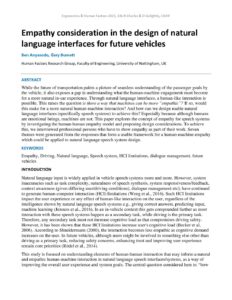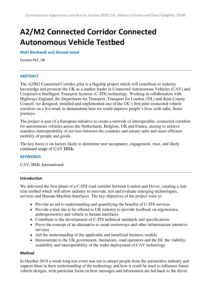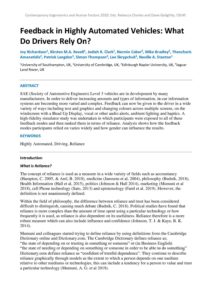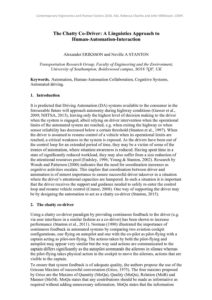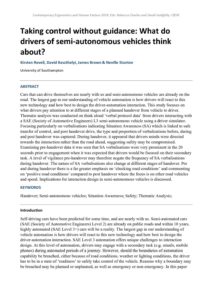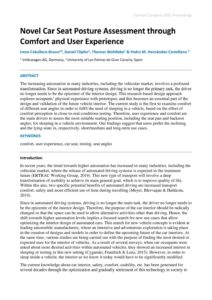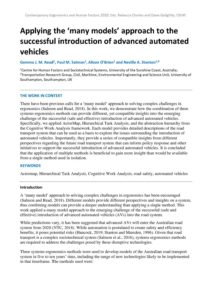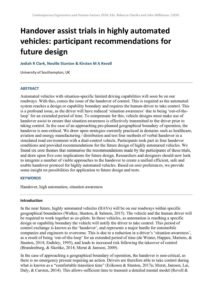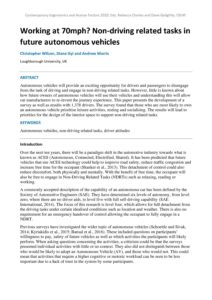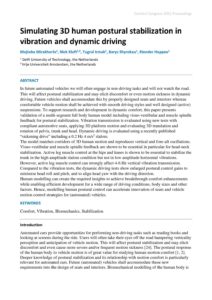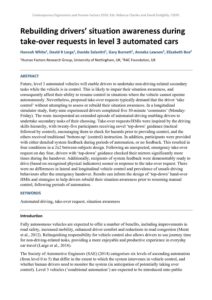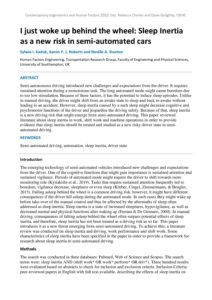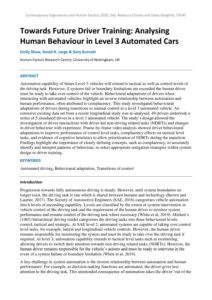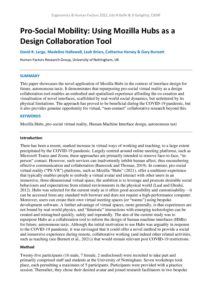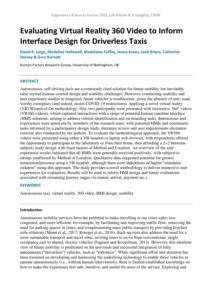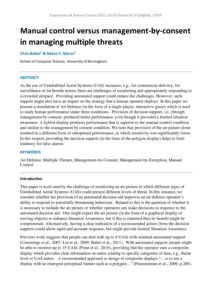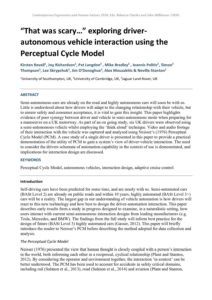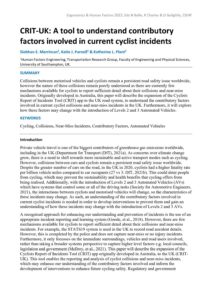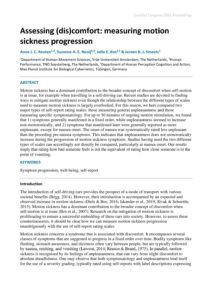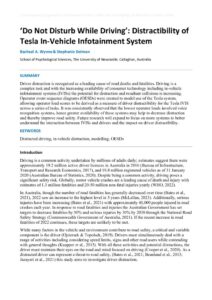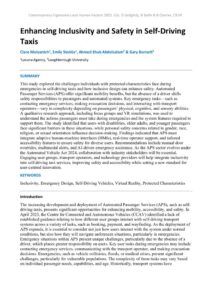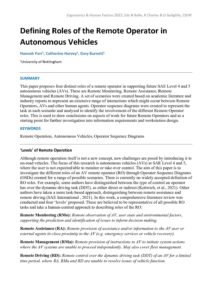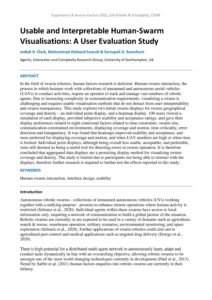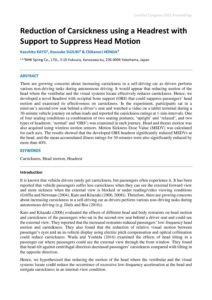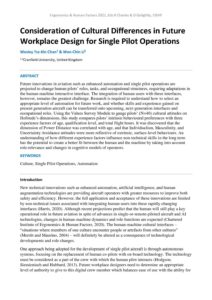Autonomous vehicles
Ghost Busting: A Novel On-Road Exploration of External HMIs for Autonomous Vehicles
| Document | Author David R. Large, Madeline Hallewell, Xuekun Li, Catherine Harvey & Gary Burnett |
| Abstract The absence of a human driver in future autonomous vehicles means that explicit pedestrian-driver communication is not possible. Building on the novel ‘Ghost Driver’ methodology to emulate an autonomous vehicle, we developed prototype external human-machine interfaces to replace existing cues, and report preliminary, qualitative findings captured from a sample of pedestrians (n=64) who encountered the vehicle when crossing the road, as well as reflecting on the method. |
Empathy consideration in the design of natural language interfaces for future vehicles
| Document | Author Ben Anyasodo and Gary Burnett |
| Abstract While the future of transportation paints a picture of seamless understanding of the passenger goals by the vehicle, it also exposes a gap in understanding what the human-machine engagement must become for a more natural in-car experience. Through natural language interfaces, a human-like interaction is possible. This raises the question is there a way that machines can be more “empathic”? If so, would this make for a more natural human-machine interaction? And how can we design usable natural language interfaces (specifically speech systems) to achieve this? Especially because although humans are emotional beings, machines are not. This paper explores the concept of empathy for speech systems by investigating the human-human empathy model and proposing design considerations. To achieve this, we interviewed professional persons who have to show empathy as part of their work. Seven themes were generated from the responses that form a usable framework for a human-machine empathy which could be applied to natural language speech system design. |
A2/M2 Connected Corridor Connected Autonomous Vehicle Testbed
| Document | Author Matt Blackwell and Ahmad Jamal |
| Abstract The A2/M2 Connected Corridor pilot is a flagship project which will contribute to industry knowledge and promote the UK as a market leader in Connected Autonomous Vehicles (CAV) and Cooperative Intelligent Transport Systems (C-ITS) technology. Working in collaboration with Highways England, the Department for Transport, Transport for London (TfL) and Kent County Council, we designed, installed and implemented one of the UK’s first pilot connected vehicle corridors on a live road, to demonstrate how we could improve people’s lives with safer, faster journeys. The project is part of a European initiative to create a network of interoperable, connected corridors for autonomous vehicles across the Netherlands, Belgium, UK and France, aiming to achieve seamless interoperability of services between the countries and ensure safer and more efficient mobility of people and goods. The key focus is on factors likely to determine user acceptance, engagement, trust, and likely continued usage of CAV HMIs. |
Feedback in Highly Automated Vehicles: What Do Drivers Rely On?
| Document | Author Joy Richardson, Kirsten M.A. Revell, Jediah R. Clark, Nermin Caber, Mike Bradley, Theocharis Amanatidis, Patrick Langdon, Simon Thompson, Lee Skrypchuk, Neville A. Stanton |
| Abstract SAE (Society of Automotive Engineers) Level 3 vehicles are in development by many manufacturers. In order to deliver increasing amounts and types of information, in-car information systems are becoming more varied and complex. Feedback can now be given to the driver in a wide variety of ways including text and graphics and changing colours across multiple screens, on the windscreen with a Head Up Display, vocal or other audio alerts, ambient lighting and haptics. A high-fidelity simulator study was undertaken in which participants were exposed to all of these feedback modes and then ranked them in terms of reliance. Analysis shows how the feedback modes participants relied on varies widely and how gender can influence the results. |
The Chatty Co-Driver: A Linguistics Approach to Human-Automation-Interaction
| Document | Author Alexander ERIKSSON and Neville A STANTON |
| Abstract |
Taking control without guidance: What do drivers of semi-autonomous vehicles think about?
| Document | Author Kirsten Revell, David Keszthelyi, James Brown & Neville Stanton |
| Abstract Cars that can drive themselves are nearly with us and semi-autonomous vehicles are already on the road. The largest gap in our understanding of vehicle automation is how drivers will react to this new technology and how best to design the driver-automation interaction. This study focuses on what drivers pay attention to at different stages of a planned handover from vehicle to driver. Thematic analysis was conducted on think aloud ‘verbal protocol data’ from drivers interacting with a SAE (Society of Automotive Engineers) L3 semi-autonomous vehicle using a driver simulator. Focusing particularly on verbalisations indicating Situation Awareness (SA) which is linked to safe transfer of control, and post handover drive, the type and proportion of verbalisations before, during and post handover was captured. During handover, it appeared that drivers minds were directed towards the interaction rather than the road ahead, suggesting safety may be compromised. Examining pre-handover data it was seen that SA verbalisations were very prominent in the 20 seconds prior to engagement when it was expected that drivers would be focused on their secondary task. A level of vigilance pre-handover may therefore negate the frequency of SA verbalisations during handover. The nature of SA verbalisations also change at different stages of handover. Pre and during handover there is a far greater emphasis on ‘checking road conditions’ and commenting on ‘positive road conditions’ compared to post handover where the focus is on other road vehicles and speed. Implications for interaction design in semi-autonomous vehicles is discussed. |
Novel Car Seat Posture Assessment through Comfort and User Experience
Introducing CHAT to Improve Driver Performance during Level 3 Automated Driving
| Document | Author Emily Shaw, David R. Large, Gary Burnett, Elizabeth Box |
| Abstract Intermediate levels of automation will place new demands on drivers. At this level, system capability allows drivers to turn their attention to non-driving tasks, but system boundaries will require the driver to takeover control when requested and required. Drivers will need to learn how to interact and share control with the system to smoothly transition between modes of automation during dynamic operations. This study introduces “CHAT” (CHeck, Assess, Takeover) as a novel framework designed to improve drivers’ performance during level 3 automated driving. It was evaluated and validated as part of a pre-drive “behavioural” training intervention, during a between-subjects driving simulator study (n=24), with drivers receiving either behavioural training or a written operating manual. Results suggest immediate, positive effects from behavioural training on drivers’ tactical level task performance, most notably visual behaviour, during automated driving and transition of control, and faster disengagement from non-driving tasks following a takeover request. It is suggested that the early engagement in re-building situation awareness, demonstrated by these drivers, led to more informed and measured decision making in relation to the lane change manoeuvre immediately after takeover. Findings support the establishment of a proof-of-concept relating to this proposed training approach. Future studies will focus on further validation and using the novel CHAT procedure to inform the design and development of a human machine interface to support the uptake and maintenance of desired driver behaviours. |
Applying the ‘many models’ approach to the successful introduction of advanced automated vehicles
| Document | Author Gemma J. M. Read, Paul M. Salmon, Alison O’Brien and Neville A. Stanton |
| Abstract There have been previous calls for a ‘many model’ approach to solving complex challenges in ergonomics (Salmon and Read, 2018). In this work, we demonstrate how the combination of three systems ergonomics methods can provide different, yet compatible insights into the emerging challenge of the successful (safe and effective) introduction of advanced automated vehicles. Specifically, we applied ActorMap, Hierarchical Task Analysis, and the abstraction hierarchy from the Cognitive Work Analysis framework. Each model provides detailed descriptions of the road transport system that can be used as a basis to explore the issues surrounding the introduction of automated vehicles. Importantly, they provide a series of compatible insights from different perspectives regarding the future road transport system that can inform policy response and other initiatives to support the successful introduction of advanced automated vehicles. It is concluded that the application of multiple methods is beneficial to gain more insight than would be available from a single method used in isolation. |
Handover assist trials in highly automated vehicles: participant recommendations for future design
| Document | Author Jediah R Clark, Neville Stanton & Kirsten M A Revell |
| Abstract Automated vehicles with situation-specific limited driving capabilities will soon be on our roadways. With this, comes the issue of the handover of control. This is required as the automated system reaches a design or capability boundary and requires the human-driver to take control. This is a profound issue, as the driver will have reduced ‘situation awareness’ due to being ‘out-of-the-loop’ for an extended period of time. To compensate for this, vehicle designs must make use of handover assist to ensure that situation awareness is effectively transmitted to the driver prior to taking control. In the case of an approaching pre-planned geographical boundary of operation, the handover is non-critical. We draw upon strategies currently practiced in domains such as healthcare, aviation and energy manufacturing / distribution and test four methods of verbal handover in a simulated road environment with a dual-control vehicle. Participants took part in four handover conditions and provided recommendations for the future design of highly automated vehicles. We found six core themes that summarise the recommendations made by the participants of these trials, and draw upon five core implications for future design. Researchers and designers should now look to integrate a number of viable approaches to the handover to create a unified efficient, safe and usable handover protocol for highly automated vehicles. Based on user preferences, we provide some insight on possibilities for application to future design and tests. |
Working at 70mph? Non-driving related tasks in future autonomous vehicles
| Document | Author Christopher Wilson, Diane Gyi and Andrew Morris |
| Abstract Autonomous vehicles will provide an exciting opportunity for drivers and passengers to disengage from the task of driving and engage in non-driving related tasks. However, little is known about how future owners of autonomous vehicles will use their vehicles and understanding this will allow car manufacturers to re-invent the journey experience. This paper presents the development of a survey as well as results with 1,378 drivers. The survey found that those who are most likely to own an autonomous vehicle prioritise leisure activities, resting and socialising. The results will lead to priorities for the design of the interior space to support non-driving related tasks. |
Simulating 3D human postural stabilization in vibration and dynamic driving
Rebuilding drivers’ situation awareness during take-over requests in level 3 automated cars
| Document | Author Hannah White, David R Large, Davide Salanitri, Gary Burnett, Anneka Lawson, Elizabeth Box |
| Abstract Future, level 3 automated vehicles will enable drivers to undertake non-driving-related secondary tasks while the vehicle is in control. This is likely to impair their situation awareness, and consequently affect their ability to resume control in situations where the vehicle cannot operate autonomously. Nevertheless, proposed take-over requests typically demand that the driver ‘take control’ without attempting to assess or rebuild their situation awareness. In a longitudinal simulator study, forty-nine experienced drivers completed five 30-minute ‘commutes’ (Monday-Friday). The route incorporated an extended episode of automated driving enabling drivers to undertake secondary tasks of their choosing. Take-over requests/HMIs were inspired by the driving skills hierarchy, with twenty-five participants receiving novel ‘top-down’ guidance (tactical followed by control), encouraging them to check for hazards prior to providing control, and the others received traditional ‘bottom-up’ (control) instruction. In addition, participants were provided with either detailed system feedback during periods of automation, or no feedback. This resulted in four conditions in a 2x2 between-subjects design. Following an unexpected, emergency take-over request on day four, drivers with ‘top-down’ guidance checked their mirrors significantly more times during the handover. Additionally, recipients of system feedback were demonstrably ready to drive (based on recognised physical indicators) sooner in response to the take-over request. There were no differences in lateral and longitudinal vehicle control and prevalence of unsafe driving behaviours after the emergency handover. Results can inform the design of ‘top-down’ hand-over HMIs and strategies to help drivers rebuild their situation awareness prior to resuming manual control, following periods of automation. |
I just woke up behind the wheel: Sleep Inertia as a new risk in semi-automated cars
| Document | Author Sylwia I. Kaduk, Aaron P. J. Roberts and Neville A. Stanton |
| Abstract Semi-autonomous driving introduced new challenges and expectations from the driver. It requires sustained attention during a monotonous task. The long automated mode might cause boredom due to too low stimulation. Because of these factors, it has the potential to induce sleep episodes. Unlike in manual driving, the driver might shift from an awake state to sleep and back to awake without leading to an accident. However, sleep inertia caused by a such sleep might decrease cognitive and psychomotor functions of the driver and jeopardise the driving safety. Because of that, sleep inertia is a new driving risk that might emerge from semi-automated driving. This paper reviewed literature about sleep inertia in work, shift work and machine operations in order to provide evidence that sleep inertia should be treated and studied as a new risky driver state in semi-automated driving. |
Towards Future Driver Training: Analysing Human Behaviour in Level 3 Automated Cars
| Document | Author Emily Shaw, David R. Large and Gary Burnett |
| Abstract Automation capability of future Level 3 vehicles will extend to tactical as well as control levels of the driving task. However, if systems fail or boundary limitations are exceeded the human driver must be ready to take over control of the vehicle. Behavioural adaptations of drivers when interacting with automated vehicles, highlight an inverse relationship between automation and human performance, often attributed to complacency. This study investigated behavioural adaptations of drivers during transitions to manual control in a level 3 automated vehicle. An extensive existing data set from a recent longitudinal study was re-analysed. 49 drivers undertook a series of 5 simulated drives in a level 3 automated vehicle. The study’s design allowed the investigation of driver interactions with driver-led non-driving related tasks (NDRTs) and changes in driver behaviour with experience. Frame-by-frame video analysis showed driver behavioural adaptations to improve performance of control level tasks, complacency effects on tactical level tasks, and evidence of cognitive heuristics to allow prioritisation of NDRTs during the transition. Findings highlight the importance of clearly defining concepts, such as complacency, to accurately identify and interpret patterns of behaviour, to select appropriate mitigation strategies within system design or driver training. |
Pro-Social Mobility: Using Mozilla Hubs as a Design Collaboration Tool
| Document | Author David R. Large, Madeline Hallewell, Leah Briars, Catherine Harvey & Gary Burnett |
| Abstract This paper showcases the novel application of Mozilla Hubs in the context of interface design for future, autonomous taxis. It demonstrates that repurposing pro-social virtual reality as a design collaboration tool enables an embodied and spatialised experience affording the co-creation and visualisation of novel interfaces, scaffolded by real-world social dynamics, but unfettered by its physical limitations. The approach has proved to be beneficial during the COVID-19 pandemic, but it also provides genuine opportunity for virtual, “non-contact” collaborative research beyond this. |
Evaluating Virtual Reality 360 Video to Inform Interface Design for Driverless Taxis
| Document | Author David R. Large, Madeline Hallewell, Madelaine Coffey, Jenna Evans, Leah Briars, Catherine Harvey & Gary Burnett |
| Abstract Autonomous, self-driving taxis are a commonly cited solution for future mobility but inevitably raise myriad human-centred design and usability challenges. However, conducting usability and user experience studies in imagined, future vehicles is troublesome, given the absence of safe, road-worthy exemplars (and indeed, recent COVID-19 restrictions). Applying a novel virtual reality (VR) Wizard-of Oz methodology, fifty-two participants were presented with immersive 360° videos (VR360-videos), which captured interactions with a range of potential human-machine interface (HMI) solutions, aiming to address vehicle identification and on-boarding tasks. Interactions and experiences were acted out by members of the research team, with potential HMIs and constituent tasks informed by a participatory design study, literature review and user requirements elicitation exercise also conducted by the authors. To evaluate the methodological approach, the VR360-videos were presented using either a VR-headset or laptop web-browser, with respondents offered the opportunity to participate in the laboratory or from their home, thus affording a 2×2 between-subjects study design with fixed factors of Method and Location. An overview of the user experience results indicated that all HMIs were generally received positively, with subjective ratings unaffected by Method or Location. Qualitative data suggested potential for greater immersion/presence using a VR-headset, although there were indications of higher “simulator sickness” using this approach. The study provides a novel methodology to deliver immersive user experiences for evaluation. Results will be used to inform HMI design and future evaluations associated with remaining journey stages (in-transit, arrival, payment etc.). |
Manual control versus management-by-consent in managing multiple threats
| Document | Author Chris Baber & Natan S. Morar |
| Abstract As the use of Uninhabited Aerial Systems (UAS) increases, e.g., for commercial delivery, for surveillance or for hostile action, there are challenges of monitoring and appropriately responding to a crowded airspace. Providing automated support could reduce the challenges. However, such support might also have an impact on the strategy that a human operator deploys. In this paper we present a simulation of Air Defence (in the form of a single-player, interactive game) which is used to study human performance under three conditions. Provision of decision support, i.e., through management by consent, produced better performance, even though it provided a limited situation awareness. A hybrid display produces performance that is superior to the manual control condition and similar to the management by consent condition. We note that provision of the air picture alone resulted in a different form of suboptimal performance, in which sensitivity was significantly lower. In this respect, providing the decision support (in the form of the polygon display) helps to limit tendency for false alarms. |
Space Utilisation and Comfort in Automated Vehicles: A Shift in Interior Car Design?
“That was scary…” exploring driver-autonomous vehicle interaction using the Perceptual Cycle Model
| Document | Author Kirsten Revell, Joy Richardson, Pat Langdon, Mike Bradley , Ioannis Politis, Simon Thompson, Lee Skrypchuk, Jim O’Donoghue, Alex Mouzakitis & Neville Stanton |
| Abstract Semi-autonomous cars are already on the road and highly autonomous cars will soon be with us. Little is understood about how drivers will adapt to the changing relationship with their vehicle, but to ensure safety and consumer acceptance, it is vital to gain this insight. This paper highlights evidence of poor synergy between driver and vehicle in semi-autonomous mode when preparing for a manoeuvre on a UK motorway. As part of an on going study, six UK drivers were observed using a semi-autonomous vehicle whilst employing the ‘think aloud’ technique. Video and audio footage of their interaction with the vehicle was captured and analysed using Neisser’s (1976) Perceptual Cycle Model (PCM). A case study of a single driver is presented in this paper to provide a practical demonstration of the utility of PCM to gain a system’s view of driver-vehicle interaction. The need to consider the drivers schemata of automation capability in the context of use is demonstrated, and implications for interaction design are discussed. |
CRIT-UK: A tool to understand contributory factors involved in current cyclist incidents
| Document | Author Siobhan E. Merriman, Katie J. Parnell & Katherine L. Plant |
| Abstract Collisions between motorised vehicles and cyclists remain a persistent road safety issue worldwide, however the nature of these collisions remain poorly understood as there are currently few mechanisms available for cyclists to report sufficient detail about their collisions and near-miss incidents. Originally developed in Australia, this paper will describe the expansion of the Cyclists Report of Incidents Tool (CRIT) app to the UK road system, to understand the contributory factors involved in current cyclist collisions and near-miss incidents in the UK. Furthermore, it will explore how these factors may change with the introduction of Levels 2 and 3 Automated Vehicles. |
Assessing (dis)comfort: measuring motion sickness progression
‘Do Not Disturb While Driving’ Distractibility of Tesla In-Vehicle Infotainment System
| Document | Author Rachael A. Wynne & Stephanie Dolman |
| Abstract Driver distraction is recognised as a leading cause of road deaths and fatalities. Driving is a complex task and with the increasing availability of consumer technology including in-vehicle infotainment systems (IVISs) the potential for distraction and resultant collisions is increasing. Operator event sequence diagrams (OESDs) were created to model use of the Tesla system, allowing operator load scores to be derived as a measure of driver distractibility for the Tesla IVIS across a series of tasks. It was consistently observed that the lowest operator loads involved voice recognition systems, hence greater availability of these systems may help to decrease distraction and thereby improve road safety. Future research will expand to focus on more systems to better understand the interaction between IVISs and drivers and the impact on driver distractibility. |
Experimental investigation of preferred seating positions and postures in reclined seating configurations
Enhancing Inclusivity and Safety in Self-Driving Taxis
| Document | Author Clare Mutzenich, Emily Stobbs, Ahmed Ehab Abdelsalam & Gary Burnett |
| Abstract This study explored the challenges individuals with protected characteristics face during emergencies in self-driving taxis and how inclusive design can enhance safety. Automated Passenger Services (APS) offer significant mobility benefits, but the absence of a driver shifts safety responsibilities to passengers and automated systems. Key emergency tasks—such as contacting emergency services, making evacuation decisions, and interacting with transport operators—vary in complexity depending on passengers’ physical, cognitive, and sensory abilities. A qualitative research approach, including focus groups and VR simulations, was used to understand the actions passengers must take during emergencies and the system features required to support them. The study identified that users with disabilities, older adults, and younger passengers face significant barriers in these situations, while personal safety concerns related to gender, race, religion, or sexual orientation influence decision-making. Findings indicated that APS must integrate adaptive human-machine interfaces (HMIs), real-time operator support, and tailored accessibility features to ensure safety for diverse users. Recommendations include manual door overrides, multimodal alerts, and AI-driven emergency assistance. As the APS sector evolves under the Automated Vehicle Act 2024, collaboration with industry stakeholders will be essential. Engaging user groups, transport operators, and technology providers will help integrate inclusivity into self-driving taxi services, improving safety and accessibility while setting a new standard for user-centred innovation. |
Defining Roles of the Remote Operator in Autonomous Vehicles
| Document | Author Hannah Parr, Catherine Harvey & Gary Burnett |
| Abstract This paper proposes four distinct roles of a remote operator in supporting future SAE Level 4 and 5 autonomous vehicles (AVs). These are Remote Monitoring, Remote Assistance, Remote Management and Remote Driving. A set of scenarios were created based on academic literature and industry reports to represent an extensive range of interactions which might occur between Remote Operators, AVs and other human agents. Operator sequence diagrams were created to represent the task in each scenario and analysed to identify the involvement of the different Remote Operator roles. This is used to draw conclusions on aspects of work for future Remote Operators and as a starting point for further investigation into information requirements and workstation design. |
Usable and Interpretable Human-Swarm Visualisations: A User Evaluation Study
| Document | Author Jediah R. Clark, Mohammad Divband Soorati & Sarvapali D. Ramchurn |
| Abstract In the field of swarm robotics, human factors research is deficient. Human-swarm interaction, the process in which humans work with collections of unmanned and autonomous aerial vehicles (UAVs) to conduct activities, require an operator to track and manage vast numbers of robotic agents. Due to increasing complexity in communication requirements, visualising a swarm is challenging and requires usable visualisation methods that do not detract from user-interpretability and swarm transparency. This study explores two initial swarm-displays for swarm geographical coverage and density – an individual point display, and a heatmap display. 100 users viewed a simulation of each display, provided subjective usability and acceptance ratings, and gave their display preferences related to eight contextual factors related to time constraints, swarm size, communication-constrained environments, displaying coverage and motion, time-criticality, error detection and transparency. It was found that heatmaps improved usability and acceptance, and were preferred for displaying coverage and motion, and when UAV numbers are high or when time is limited. Individual point displays, although being overall less usable, acceptable, and preferable, were still deemed as being a useful tool for detecting errors in swarm operation. It is therefore concluded that aggregated data displays are a promising display method for visualising swarm coverage and density. The study is limited due to participants not being able to interact with the displays, therefore further research is required to further test the effects reported in this study. |
Reduction of Carsickness using a Headrest with Support to Suppress Head Motion
Consideration of Cultural Differences in Future Workplace Design for Single Pilot Operations
| Document | Author Wesley Tsz-Kin Chan & Wen-Chin Li |
| Abstract Future innovations in aviation such as enhanced automation and single pilot operations are projected to change human pilots’ roles, tasks, and occupational structures, requiring adaptations in the human-machine interactive interface. The integration of human users with these interfaces, however, remains the greatest challenge. Research is required to understand how to select an appropriate level of automation for future work, and whether skills and experience gained on present generation aircraft can be transferred onto upcoming, next-generation interfaces and occupational roles. Using the Values Survey Module to gauge pilots’ (N=40) cultural attitudes on Hofstede’s dimensions, this study compares pilots’ intrinsic behavioural preferences with three experience factors of age, qualification level, and total flight hours. It was discovered that the dimension of Power Distance was correlated with age, and that Individualism, Masculinity, and Uncertainty Avoidance attitudes were more reflective of extrinsic, surface-level behaviours. An understanding of how different experience factors influence non-technical skills in the long term has the potential to create a better fit between the human and the machine by taking into account role-relevance and changes in cognitive models of operators. |


